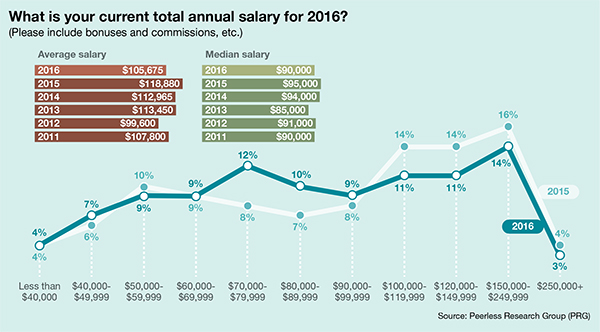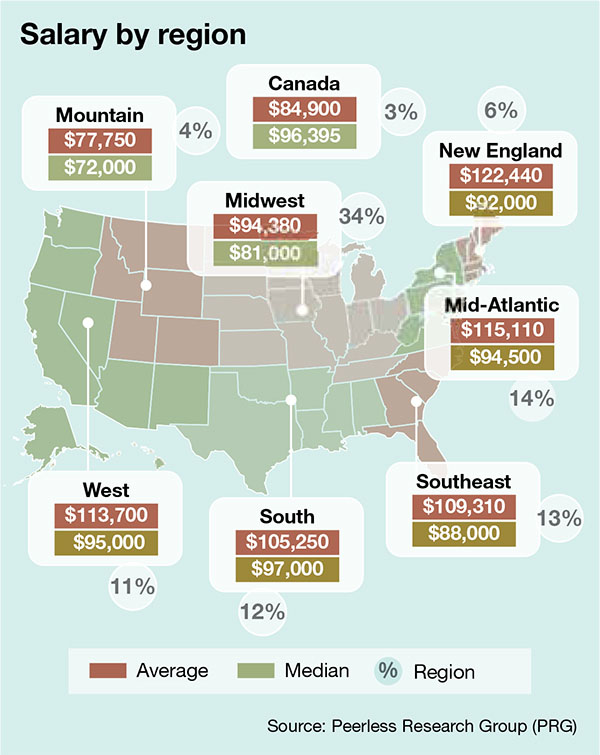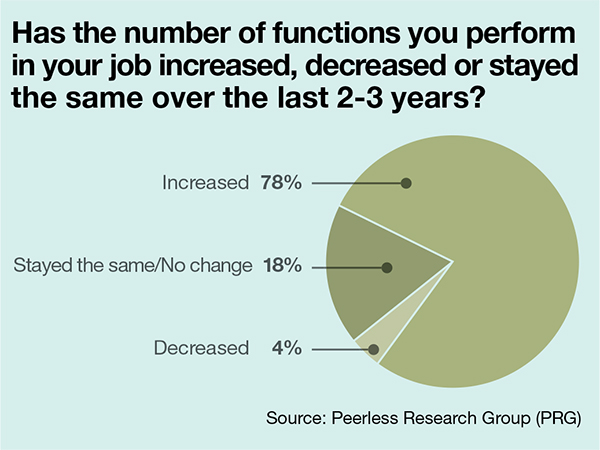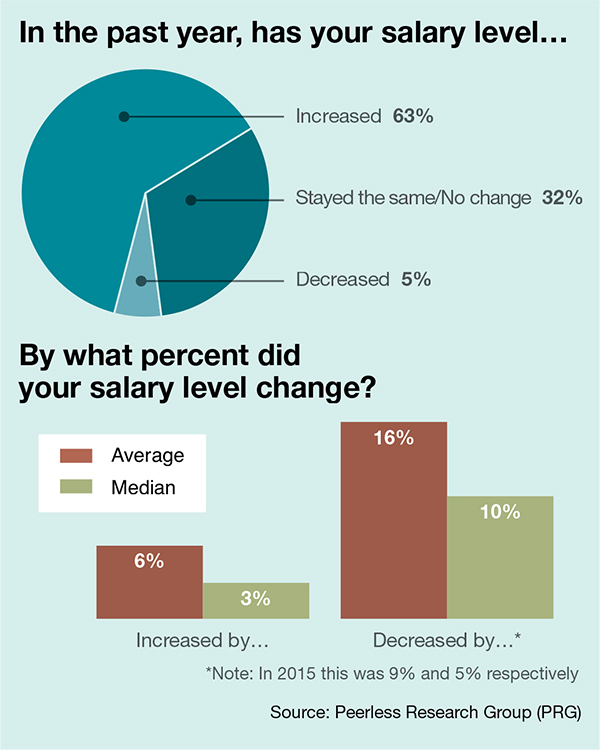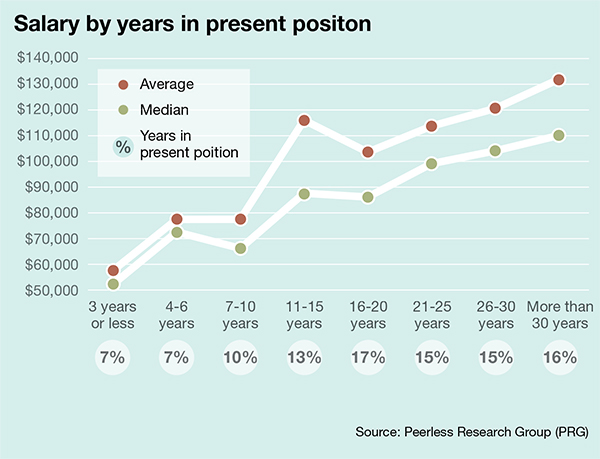2016 Salary Survey: Are Salaries set to Surge?
A record number of respondents tell us that digitized supply chains and e-commerce may soon help to drive up pay. But for now, compensation has hit a wall and may not improve until “boomers” move on and millennials move in.
“The level of frustration in this regard is palpable,” says PRG’s research director Judd Aschenbrand. “Overall compensation remained fairly flat, but new professionals entering the workforce are probably going to change that. They will also expect to be equipped with better tools for working in ‘digitized’ supply chains.”
One telling statistic, adds Aschenbrand, is that 78% of our respondents report that the number of functions that they’re asked to perform has increased over the past year. “Only 18% say that things have remained the same, and a paltry 4% say that there’s been a decrease in the duties they’re charged to execute,” he observes.
Meanwhile, median salaries (including bonuses and commissions) dropped from $95,000 in 2015, to $90,000. Paradoxically, 63% of our respondents still note that their compensation continues to improve or keep pace with the cost of living. However, this drop off in earnings may reflect the changing demographics in our industry, as “baby boomers” retire and millennials move it to fill the gap, explain PRG analysts.
Last year at this time, 43% of the respondents were in the 55-64 year-old range. This year it’s 28%—a significant slide. At the same time, managers in the 45-54 year-old range took the hardest hit in this decline, with median earnings going down from $97,000 in 2015 to $94,500 in 2016. Those managers approaching retirement in the 55-64 year-old category saw their income go from $94,500 to $94,000.
The sweet spot in all of this can still be seen in the silo comprising young, upwardly mobile managers who may expect to see earnings rise from $58,00 at age 35 to $87,800 by the time they reach age 44.
Both male and female logistics professionals saw a fall in income—men from $100,000 to $92,000 and women from $75,000 to $70,000. Which begs the question: Will those young people hired by publicly-owned companies be promised stock options and other incentives to address this trend?
For the first time in our survey’s history, researchers drilled down to discover that median compensation for publicly-owned companies was $102,000, while private companies provided far less—$80,000. Most respondents, though (65%) are working in the private sector. The minority making better money (33%) may owe the difference to stockholder pressure to out-perform the competition.
And finally, you can bet that managers out there have a pretty good idea of what their peers are earning. Interest in social networks ramped up from 56% last year to 61% in 2016. Judging by the number of candid and anecdotal answers PRG gathered, it also appears that most respondents are always ready to move on to greener pastures—even if currently “satisfied” with the status quo.
The Amazon factor
A variety of macro-economic and social developments are changing the poplar perception of our industry—and may even be bringing some glamour to it.
Tisha Danehl, vice president of Ajilon Professional Staffing in Chicago, says that demand for supply chain professionals in manufacturing and retail has “gone through the roof.” And women are finally breaking into the top echelons of what had been a male-dominated industry.
“Our agency has seen a 45% increase in demand for logistics and supply chain jobs, and an 80% increase over the past two years,” says Danehl. “It’s by far the fastest growing segment in our portfolio.” Amazon has put supply chain on the map, she adds, while public awareness of supply chain’s crucial role in world commerce is giving college grads a new career path to consider.
“And it’s not just men anymore,” says Danehl. “Companies have been looking beyond gender for some time now. With social networking, young people are sharing job leads and their enthusiasm for supply chain vocations.”
She also notes that employers demand so-called “soft skills,” such as collaboration, creativity, problem solving and multitasking for the fast-paced supply chain work environment—strengths that many strong females happen to possess. It’s shown time and again that these skills can improve employee engagement and make for smooth-running operations.
Rodger Howell, a principal with PwC’s logistics management division specializing in strategy and operations, sees a few other key areas that should be central to corporate efforts during 2016.
Howell says that “cash rich” companies—particularly in the tech sector—will continue to invest aggressively in research and development. He adds that these players need to maximize the efficiency and reliability of corporate operations, both supply chain and otherwise, to meet today’s multifaceted challenges.
“Digital technology will become increasingly integral to companies,” says Howell. “Organizations in every facet of the economy will need to realign their operations to compete in a digital world,” says Howell.
This sure to be a year of transformation, and Howell sees significant opportunity for logistics managers to position themselves for success through proactive renovation of the operational processes. “Businesses are counting on new hires to bring fresh insights on how leading edge technologies can be used in their companies,” he says. “Seasoned employees expect the new hires to bring different perspectives that will help them drive change into to their supply chains and build new capabilities.”
However, in this environment, the bar for hiring the new employee is set even higher: Not only are they expected to know the technology, but also in many cases companies want them to know and truly understand the business. “As such, new hires need to focus on ways to use digital to deliver new levels of supply chain performance,” adds Howell.
Retaining talent
For the first time in many years, PRG found that there’s been a slight decline in the number of survey respondents who would recommend this field to their son, daughter or friend—down from 83% to 79%.
At the same time, 80% of respondents say that they’ve seen a surge in the number of young people entering the industry. This disconnect may be partly explained by those who voiced concern that they are not being given the “tools” they need; however, we also found many young people who are thriving in their new jobs.
Jason Lords is a 35-year-old senior logistics manager with Zachary Industrial Inc., a company that serves the refining, chemical, power, and pulp and paper manufacturing industries. He spent the first 11 years in the industry working for a prominent publicly-held 3PL.
Now that he’s with a privately-held shipper, Lords says that the company’s focus on “continuing improvement” means that he can move forward in his career as well. “We are given the software and technological tools needed for advanced procurement and sourcing as well as demand forecasting,” he says. “Our company’s strategic partnership with C.H. Robinson also helps us obtain those resources.”
For Summer Bautista, transportation cost manager with Yogi Tea in Eugene, Ore., continuing education is also key. She’s still in her twenties and working toward an advanced degree at American Public University where she completed her undergraduate degree.
“Understanding how to use content management system software is a big plus, but on-the-job experience is very important, too,” notes Bautista. “I was with Walmart and a major 3PL before coming to Yogi last year, and I made it clear that I understood how to manage inventory and purchasing as well as the transport cost.”
Alan Beulieu, president of ITR Economics, says that employers may have to come up with “golden handcuffs” to retain some of these younger, star players. “This new generation is prone to move from one job to the other if expectations are not met, or if promises are not kept,” he says. “But our research suggests that millennials are really raised with the same values we have. They want to get married, buy a home and raise a family—all good things for U.S. economic growth, by the way.”
M.L. Peck, senior vice president of program and product development for Institute for Supply Management (ISM), concurs, saying that millennials have been given an unfair reputation for flying from one job to another.
“Many of these future leaders have worked with the same company since graduation and show great amounts of loyalty,” says Peck. “At the same time, millennials are extremely ambitious and are looking to be challenged at their jobs. They are capable of producing great outcomes and are actively seeking those opportunities. If an organization does a poor job of recognizing young talent then there’s no hesitation to move on.”
Amy Georgi, a 30-year-old program manager in supply chain acquisitions and integrations with Fluke Electronics, a Danaher Company, admits to being “an anomaly in this arena.” She’s been with the same company since graduating in 2007, but has seen many friends and close co-workers of her generation come and go through her workplace and other successive jobs.
“I believe that this trend will continue up to a certain point,” says Georgi. “It’s a natural progression for many professionals to get married and start families. And as you add other people to your life, I would say the majority of professionals become less geographically flexible.”
And staying the course with your current position has other advantages. Just take a look at Keith Rhodes, director of supply chain management at Fellers’ Inc. in Tulsa, Okla., where he’s been for the past 20 years. A former engineer with a major multinational aircraft manufacturer, he switched careers after 18 years there to move on to a new challenge.
“Logistics and supply chain is a much more interesting field,” says Rhodes. “Once you make this choice, your responsibilities range from purchasing, inventory management, warehousing and beyond. It’s really more than a science. It’s an art.”
Rhodes, like many other survey respondents we spoke with, cautions millennials against expecting immediate gratification. He says recognition in logistics and supply chain management takes time, and it’s not always dished out in the same manner that sales and marketing professionals receive.
“Those of us in logistics have to manage behind the scenes and really work as team players,” adds Rhodes. “The complexity of our jobs is not easy to measure at first, but CFOs are now seeing that we can make major contributions to the bottom line.”

